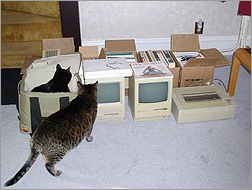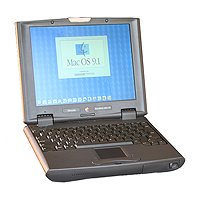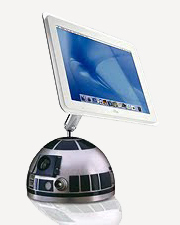In preparation for the upcoming VMM Open House, I’m setting up a Mac 512k running System 1.1 from a 400k floppy disk. Last time I used the 512k (several years back) I had 2 working internal and external Single Sided drives, plus a few spares. However these old 400k mechanisms do not age well, the lubricants slowly dry up over time and then you can’t insert or eject a disk.
I primarily use a Mac Plus and newer systems in the Museum, so these drives haven’t been touched in a few years. I guess I should consider using hermetically sealed storage for these parts, as significantly more lube drying has occurred in the 400k mechanisms in the last few years. I’m now down to one working internal drive, no working externals, and a box of frozen spares. Barely enough for the Open House. Looks like I need to tear down and try to relubricate these old mechanisms – or find someone who knows how to without using WD40!
 Acquired a major pile o’ stuff for the VMM this week, donated by a Cult of Mac member who wanted to see his old items go to a good home. My favorite way to grow the Museum!
Acquired a major pile o’ stuff for the VMM this week, donated by a Cult of Mac member who wanted to see his old items go to a good home. My favorite way to grow the Museum!
The batch included a Mac Plus and an SE/30 (neither fully functional but good for parts), an Apple ImageWriter I, MacWorld magazine issue #1 (in mint condition), a clean beige Mac carry bag with the Apple colored logo, and several boxes of old software, books and manuals.
My cats Fudge and Oreo helped me assess the goods upon arrival. A hearty thanks to Dr. Will Pitts of Auburn, MA for his generous contribution to the Vintage Mac Museum!
Performed a rather straightforward Old Mac file transfer job this weekend, but it highlighted many of the issues involved in the retrieval process, so thought I’d post details here.
My client sent four double-sided (800k) disks containing old research data in Microsoft Word v3 format. Three of the disks were readable right away with my Wallstreet floppy drive, but the fourth disk gave the dreaded “This disk is unreadable, do you wish to Format or Eject” message. Obviously clicking Format was not an option.
I tried the disk in my Quadra 840av, same result, so I fired up the old Mac Plus. This could read it, I have an external 800k floppy on this Plus which is just The Balls. When disks aren’t readable in any other machine, they almost always work in this drive. I will mourn the day it eventually dies…
The files on the Plus now need to join their brethen on the Wallstreet. The 840av serves as a bridge machine, running MacOS 8.1, the (Ethernet to) LocalTalk Bridge Control Panel, and Personal Filesharing. On the Plus the System 6 Chooser will see the Quadra as an AppleShare volume via LocalTalk (PhoneNet). Once transferred to the Quadra, I transfer the files again to the VMM Cube (my central server) via Ethernet. The Cube is accessible to the Wallstreet, so one last copy and all are finally together.
Side Note: I’m running MacOSX 10.3.9 Panther on the Cube with File Sharing Enabled. Panther supports a version of AppleShare IP that works well with all versions of MacOS from 8.1 through the latest releast of 10.5.x Leopard. Just assign your Panther machine a static IP address on your LAN, and connect to it via it’s IP address if it doesn’t show up as an AppleTalk volume. My Cube can talk to every Ethernet (or WiFi) capable Mac in my house running MacOS8 or higher!
Back to the Wallstreet. I fire up MacLinkPlus, the venerable file translation program included free with pre-OS9 Macs. It supports MS Word ’98 and MS Excel ’98 output formats, which are the popular .doc and .xls versions that modern MS Office programs use. I drop the folder full of MS Word v3 files on MacLinkPlus, specify the output folder, click Translate and BAM – hard crash.
Bus Error, hard reboot – not a good sign. Try again, same result. I copy all files to the Quadra 840av, try using an older version of MacLinkPlus on that machine, and again hard crash. Apparently MacLinkPlus does not like MS Word v3 files. Add that to the list, it also doesn’t like Word v1 or Excel v1 or v1.5. I have learned this the hard way.
I will need to use of a combination of manual and batch conversion methods. I can open the Word v3 files in MS Word v5.1a – the best Classic version of Word ever released, IMHO – and resave each one in Word v5 format, which MacLinkPlus does handle. I use Save As… and add the extension .wd5 to each new file, e.g. MyData.wd5, so I’ll later know at a glance the format of these interim files. Tedious but effective. About 100 files total in this case.
Once everything is converted to the interim format, I drag the Word v5 files onto MacLinkPlus. Click Translate and this time in a few minutes I have all the files in modern MS Word format. Except they still don’t have the right file type extensions, and are now named MyData.wd5 (Word98) A trip through a batch renaming program finishes the job, and converts each file to the correctly named MyData.doc
Copy back to the Cube, from there to my Mac Pro, and burn to CD-R. Many steps, but basically a typical conversion job. Old data never dies, it just changes format…
 I’m lucky to already have many of the Macs I want for my Museum, but there are still a few rare or relatively current items which await addition to the collection. I checked another one off the list this week with acquisition of a PowerBook 2400c, a long awaited prize.
I’m lucky to already have many of the Macs I want for my Museum, but there are still a few rare or relatively current items which await addition to the collection. I checked another one off the list this week with acquisition of a PowerBook 2400c, a long awaited prize.
As noted on the PowerBook page, the x400 series of portables (1400c, 2400c, 3400c) were a solid set of systems, after the lackluster 5300 series. The flagship 3400c had a 240MHz PowerPC 603 processor, which Apple claimed at the time was the fastest portable computer in the world, and the 2400c was a subnotebook, relatively scarce in the United States but very popular in Japan.
The 2400c is indeed a size marvel, smaller than an 8.5×11 sheet of paper and weighing in at under 4.5 pounds. The system runs at 180MHz, has a full though slightly undersized keyboard, a sharp Active Matrix screen, two PC Card slots and ADB & SCSI ports. A very good Mac OS 8/9 system, and a joy to play with and tote around. Thanks much to Alan Carvalho at Cambridge Video Productions for making this beauty available at a fair price!
The sub-notebook form factor endures in the PC marketplace, despite Apple’s lack of models in this space since the demise of the popular 12″ PowerBook and iBook G4 models (sigh…)
OK I need to start actually posting to this site so I can publicize it, no better time than the present!
An interesting New and Vintage Mac mixed job last week. A client was migrating from an iMac G4 to a new (Unibody) MacBook. They also had an archive of ClarisWorks files on a Performa 62xx series machine that they wanted to use on the new laptop. And, they preferred to use ClarisWorks instead of Microsoft Office on the new computer if possible.
Transferring from the iMac to the MacBook was relatively easy, although the new MacBook’s lack of a FireWire port no longer makes Target Disk Mode a viable transfer option for this model (sigh…) They didn’t have a lot of data, however, so I just copied their personal files and a few applications to a USB flash drive, and from there onto the MacBook.
ClarisWorks morphed into AppleWorks before being discontinued by Apple many years ago. However copies are still available for sale online. Apple gave one last gift of life to this venerable product by updating it (in version 6) to run under Carbon in MacOS9, and thus later in MacOSX. AppleWorks 6.2.9 runs just fine in MacOSX Leopard on the new Intel Macs, and is speedier than ever! An Amazon.com seller had an original AppleWorks 6.2.9 install CD available, problem solved.
Getting the files off the Performa was more of a challenge. This Performa had a modem, floppy disk drive, and SCSI port. The newer Macs had USB, FireWire and Ethernet, but not the older ports. The easiest solution was to bring the Performa back to my office and transfer the files with my Museum gear.
The Performa started up fine, so I copied the ClarisWorks files to an external SCSI drive. Shut down the Performa, moved the drive to the next room, and reconnected it to a PowerBook Wallstreet which has SCSI and Ethernet. Power up, and the Wallstreet doesn’t see the external disk at all.
Odd. Maybe it doesn’t like the older HFS formatting (the Wallstreet uses HFS+ under MacOS9)? Unlikely, but I disconnect the drive again and connect it to a Quadra 840av, which uses HFS instead. No dice, same result. A drive is seen on the SCSI bus, but no volume (the actual data) is found. Can’t be read at all.
Hmmm. I try to reformat the drive, and it fails immediately. Apparently just carrying the old drive from room to room, or power cycling it on and off a few times after several dormant years, was enough to kill it. Such is life with old gear…
Awright. Repeat Process. Grab another SCSI disk from my stack, hookup in enclosure, connect to Performa, copy files, move drive to newer machine, and now everything is there. Copy files via Ethernet to my G4 Cube (the VMM central server), and then to my Mac Pro. All files open immediately in AppleWorks with no modifications. Painless – once they got there! I burn a CD-R with the files, and return the computer and disc to my client.
Next time I’ll tiptoe between rooms with the old SCSI drives…
 The Vintage Mac Museum is a working collection of 68k and PowerPC Macinti tracking the System Software, hardware design and period memorabilia of the pre-Intel Apple Macintosh. The Museum got started in the summer of 2001 while I was playing around with the then-just-released (and long awaited) MacOSX. Reminiscing a bit on Mac history, I realized I’d been a Macintosh user since the Mac Plus but had never used the original System Software. Just how much of the Mac’s later features were contained in that primal core? After a few hours poking around online I’d downloaded some early system disk images and was off and running.
The Vintage Mac Museum is a working collection of 68k and PowerPC Macinti tracking the System Software, hardware design and period memorabilia of the pre-Intel Apple Macintosh. The Museum got started in the summer of 2001 while I was playing around with the then-just-released (and long awaited) MacOSX. Reminiscing a bit on Mac history, I realized I’d been a Macintosh user since the Mac Plus but had never used the original System Software. Just how much of the Mac’s later features were contained in that primal core? After a few hours poking around online I’d downloaded some early system disk images and was off and running.
Old 68k Macs were easy to come by, so I decided to assemble a subjective collection of best of breed or otherwise notable models running period applications and versions of the Macintosh System Software. Soon the models began multiplying, friends donated old Macs and I assembled a nice little history of the 68k era. The Museum is a hands-on, functioning collection and I fritter away more time than I should acquiring and cleaning up old machines. But you never know when you might need to read a 400k floppy or run some classic Mac software!
In 2005 Apple shocked the world (again) by announcing its shift to the Dark Side, a transition of the platform from PowerPC to Intel CPUs. Unthinkable only a few years earlier and confirming longstanding rumors, Apple acknowledged that they had been compiling MacOSX on Intel since it’s conversion from NeXTstep. It was a successful move for Apple, and the Mac now has its strongest market share in years. The Intel transition also made a logical boundary point for the Vintage Mac Museum, which has by now expanded beyond its 68k roots into the PowerPC era and become a pre-Intel Macintosh collection.
This blog will describe some of my efforts acquiring, maintaining and using the collection as a Mac hobbyist and professional consultant.


 Acquired a major pile o’ stuff for the VMM this week, donated by a Cult of Mac member who wanted to see his old items go to a good home. My favorite way to grow the Museum!
Acquired a major pile o’ stuff for the VMM this week, donated by a Cult of Mac member who wanted to see his old items go to a good home. My favorite way to grow the Museum! I’m lucky to already have many of the Macs I want for my Museum, but there are still a few rare or relatively current items which await addition to the collection. I checked another one off the list this week with acquisition of a PowerBook 2400c, a long awaited prize.
I’m lucky to already have many of the Macs I want for my Museum, but there are still a few rare or relatively current items which await addition to the collection. I checked another one off the list this week with acquisition of a PowerBook 2400c, a long awaited prize. The
The